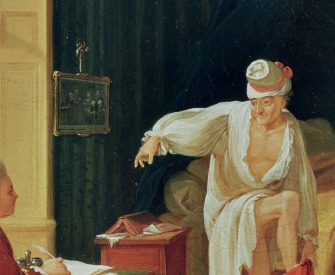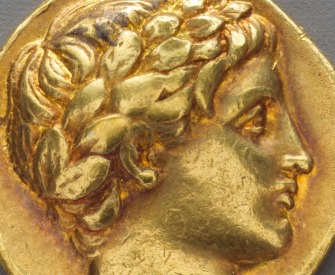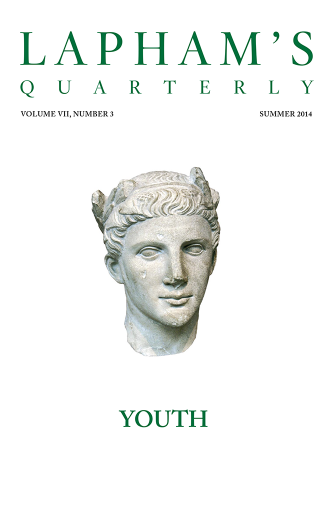Little folks become their little fate.
—Horace, 20 BCBuying Tomorrow
The future has become a financial fetish, sliced into probable outcomes to be calculated and bet upon.
By Jennifer Szalai

Still-Life of Flowers, by Ambrosius Bosschaert, 1614.
When the rest of the world are mad, we must imitate them in some measure.
—John Martin, Martin’s Bank, 1720
As long as the music is playing, you’ve got to get up and dance.
—Charles Prince, Citigroup, 2007
It would be fair to guess that Charles Prince’s echo of John Martin, a banker who was nearly ruined by the South Sea Bubble, reflects a sincerity that was blissfully ignorant rather than an irony that wasn’t. One might even be willing to bet on it—if, that is, certain information about Prince’s knowledge and state of mind were actually forthcoming. A wager entails uncertainty, but without the prospect of a future event coming to pass, uncertainty is worth little besides the mystery it affords.
To cast lots for Christ’s robe, as Pontius Pilate’s soldiers did, was to play a game of chance. Gambling is one of those activities, along with religious worship and prostitution, that was popular already by the time any recording of history began. Our modern financial system owes much to this desire to make a fortune off of Fortune, though a society that organizes itself around financial risk-taking, whose national assets oscillate in an invisible cloud of ones and zeros, requires a very particular understanding of what the future can hold. Finance makes a commodity out of expectation, something to be bought (preferably low) and sold (preferably high). In the case of the worried farmer or the worried breadwinner, the future can also be viewed with suspicion, but finance enables the anxious to trade one possibility for another: both the speculator and the hedger are seeking the best future that money can buy.
As much as the old saw about money and happiness gets deployed by the usual suspects—grandmothers, clergymen, credit-card commercials—there seems to be some confusion in this country over which one is the legitimate object for pursuit. If anything, the optimistic strain that runs through American history has been a boon to the financial industry, which has literally capitalized on the belief that in the future lies prosperity. Technology has made it possible for finance to transcend the limits of the material world: so much money changing invisible hands has long since become the stuff of American dreams. And for the Chicken Littles who equate the future with decline and decrepitude, financiers found a way to make money for them (and, naturally, from them), too. Insurance for those who don’t want to lose, and short-selling for those who still want to win.
But the future was not always so amenable to our business plans. As long as the future belonged to the gods, there was little arguing with the inevitability of fate. Despite his parents’ deployment of the ultimate avoidance strategy—tie baby’s ankles together; order servant to abandon baby on mountainside—Oedipus killed his father anyway. In Against the Gods: The Remarkable Story of Risk, Peter Bernstein points out that the future had to be something other than “the murky domain of oracles and soothsayers” before it could be put “in the service of the present.”
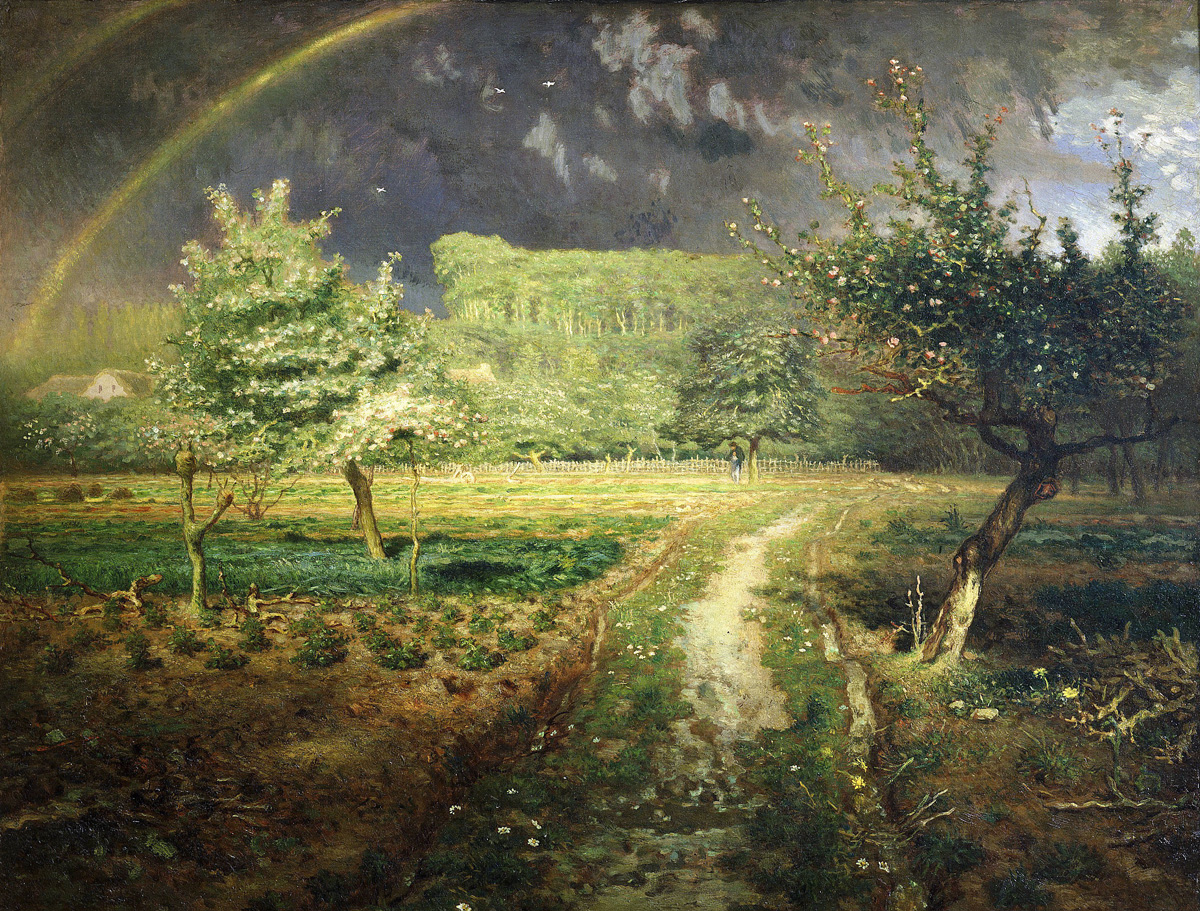
Spring, by Jean-François Millet, c. 1870. Musée d'Orsay, Paris.
Bernstein makes much of the distinction between “uncertainty” (vague, amorphous) and “risk” (precise, quantifiable). The story he tells is a march of progress, from haplessness to sophistication. The word “risk” comes from risicare, early Italian for “to dare”: one asserts a choice rather than submits to fate. By changing humanity’s relationship to God and nature, the Renaissance and the Reformation filled the future with possibility and promise. Renaissance gamblers were especially motivated to slice up the future into probable outcomes, calculating the odds of each and betting accordingly. The Chevalier de Méré, a seventeenth-century French nobleman with a penchant for gaming, boasted in a letter to Blaise Pascal that he had “discovered in mathematics things so rare that the most learned of ancient times have never thought of them and by which the best mathematicians in Europe have been surprised.” De Méré had figured out that the probability of throwing a six with four throws of one die was slightly more than 50 percent (51.77469136 percent, to be exact), and so he would throw the die many times and win small amounts, instead of hoping for a windfall—and hazarding ruin—by betting on a few chance throws.
For contemporary poker players, the parallel to De Méré’s strategy is known as “grinding,” as in grinding out a profit over an extended period of time. The strategy might also sound familiar to the common investor. Since the 1970s, when Burton Malkiel wrote about the “random walk” of an “efficient market” that was hard for even the experts to time or to beat, investors have been told to diversify (finance speak for “Don’t put your eggs in one basket”), and to buy and hold: in the long run, you should come out ahead. (A whole industry of indexed mutual funds proliferated as a result.) Of course, this advice assumes that the chance your portfolio will grow is as measurable as the chance De Méré’s die will turn up six. And it also assumes that “the long run” will be shorter than your lifetime—which, as John Maynard Keynes remarked, is far from guaranteed.
Barring the complications of willful self-destruction or insanity, the gambler and the investor are optimistically inclined. The gambler believes luck will turn in his favor; the investor believes the future will be an improvement on the past. A share in a company represents a piece of it, and as the pie grows, so should each piece. The old-fashioned stock picker ignores advice about random walks and efficient markets in favor of research into a company, which should reveal whether optimism about the future is in fact warranted. At least this is the theory at its most pristine. Benjamin Graham, professor to Warren Buffet at Columbia, wrote in 1949 about “the intelligent investor,” whom he distinguished from the mere speculator: “An investment operation is one which, upon thorough analysis, promises safety of principal and an adequate return. Operations not meeting these requirements are speculative.” The speculator is too much in thrall to “Mr. Market,” a manic-depressive who shows up every day with an offer to buy or sell shares at prices that range from reasonable to ridiculous. Mr. Market is playing the future rather than buying it. The investor makes a profit from Mr. Market’s folly, whereas the speculator participates in it.
The erratic Mr. Market, it seems, has been hanging around for as long as shares have been traded. In ancient Rome, organizations called publicani were contracted to carry out many of the functions of the Roman state, such as temple building and tax collecting, and ownership of publicani was divided into partes, or shares. Edward Chancellor, in his excellent Devil Take the Hindmost: A History of Financial Speculation, starts with the quaestors, or “seekers,” who were the financial speculators of ancient Rome. (They were also called Graeci or Greeks—which, as Chancellor surmises, may have been because many quaestors were “of Hellenic origin,” or else because the term “was a form of abuse.”) Cicero’s mention that “partes illo tempore carissimas” [shares at that time were most expensive] suggests the existence of an exchange where partes were traded and fluctuated in price. Evidence of an early Roman speculative bubble may be weak, but the example Chancellor provides has a nicely frightening ring to it. Petronius Arbiter, describing the last years of the republic, wrote about “the filthy usury and handling of money [that] had caught the people in a double whirlpool, and destroyed them…The madness spread through their limbs, and trouble bayed and hounded them down like some disease sown in the dumb flesh.”
The speculator is fixated on what everybody else is thinking, because the existence of a market in shares means that prices will be determined more often by the mentality of the herd than by the thing itself—whether it be a tulip, a pork belly, a pound sterling, or a house. In his General Theory of Employment, Interest and Money, written during the Great Depression, Keynes likened the activity to a newspaper contest in which, “The competitors have to pick out the six prettiest faces from a hundred photographs, the prize being awarded to the competitor whose choice most nearly corresponds to the average preferences of the competitors as a whole; so that each competitor has to pick, not those faces he himself finds prettiest, but those which he thinks likeliest to catch the fancy of the other competitors, all of whom are looking at the problem from the same point of view.” Even the genuine opinions of others are irrelevant, and “We devote our intelligences to anticipating what average opinion expects the average opinion to be.” As for the actual commodity, the speculator doesn’t need it, nor does he even need to see it; commodities are not so much the objects of his trade as they are its pretext. Tulips may be beautiful to look at, a lovely addition to the breakfast table, but during the height of Tulipomania in the winter of 1636–7, the bulbs were in the ground and speculators were trading pieces of paper: no tulips were actually delivered.
Divining “what average opinion expects average opinion to be” nevertheless ascribes more of a method to the speculator’s madness than might actually be the case. The competitors in Keynes’s beauty contest (the chiefs of Citigroup and Martin’s Bank among them) at least have a sense of how markets function, however distorted the hall of mirrors, whereas the history of finance is crowded with those who believed that prices were determined by natural phenomena, or else divinely ordained. William Stanley Jevons, a nineteenth-century British economist and logician who seems otherwise to have been a reasonable man, noticed that recent panics in England’s markets occurred every eleven years or so, which prompted him to attribute the panics to sunspots; he predicted the next panic would take place in 1879, and a crash in October 1878 convinced him that he was on to something. Since his death in 1882, the timetable he left behind has been proven wrong. In the burgeoning western European markets of the sixteenth century, an Antwerp trader named Christoph Kurz consulted astrological charts for future prices. (He later abandoned market forecasting for political astrology; one of his predictions was that the papacy was on the verge of extinction.) Apparently some speculators still find astrology to be as useful a guide to markets as any. The bare-bones website for the Astrologers Fund in Manhattan promises “a stellar performance.”
Admittedly, the Astrologers Fund comes across as a curio, a superstitious remnant of a time before people knew any better. Recall Peter Bernstein on the triumph of risk: he argues that we’ve long since abandoned any naive beliefs that the future is determined by stars in the sky or gods on a mountaintop, and it is this process of demystification that has allowed the financial sector to become as central and as powerful as it is. It should surprise no one that the powers of quantification which the Chevalier de Méré brought to the gambling table were put in the service of finance, which was constantly on the lookout for methods that would render the future fit for immediate consumption.
The connection between gambling and speculation might be palpably obvious, but it is in the staid world of insurance that the gambler’s calculation of the odds had its most direct application. Edmond Halley, of diving-bell and comet fame, used population statistics from Breslau to publish the first mortality table in 1693, which allowed for the development of actuarial science and, by extension, the life-insurance industry. Insurance is based on the ability to shift risk: if you want to protect the solvency of your business or your family from an unfortunate event that may or may not happen, you find somebody who is better able and more willing to shoulder that risk than you. Maybe you think it unlikely that you will expire within a certain period of time, but you are aware of the grim possibility, however remote. By purchasing life insurance, you will lose a small, discrete amount of money—your premium—with 100 percent certainty in order to insure your dependents from the small possibility of financial ruin.
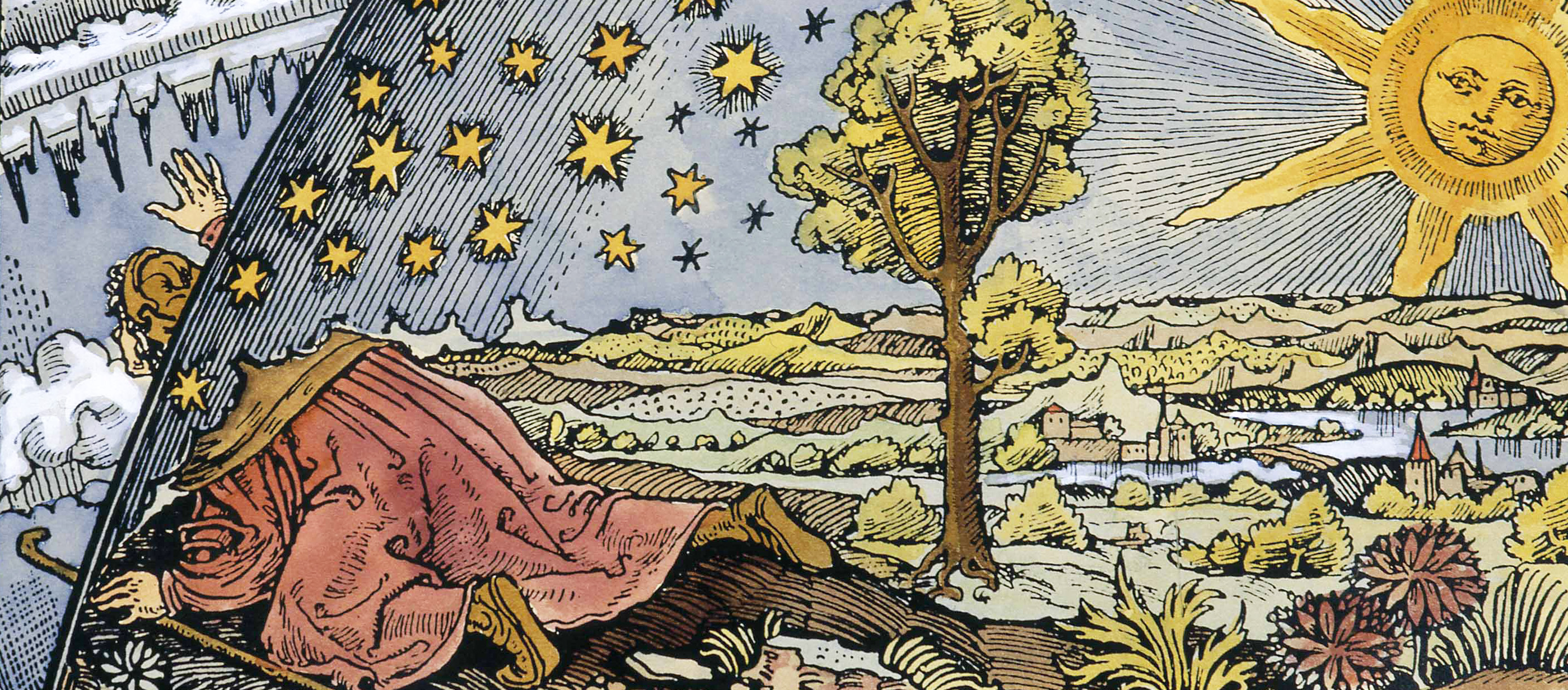
Medieval missionary discovering the point where heaven and earth meet, twentieth-century coloration of black-and-white engraving from The Atmosphere, by Camille Flammarion, 1888.
This all sounds safe and boring enough, but insurance is ultimately a bet on the future, even if it happens to be one that the bettor hopes to lose. I buy insurance, and if I die, or my house burns down, or my car veers into a tree, the insurer pays out a chunk of change—in which case, I’ve “won.” It is only the fact that a win is precipitated by a loss that distinguishes insurance from gambling. Unless insurance is properly regulated, it easily gets consumed by the gaping maw of speculation. In 1691, Daniel Defoe observed that “Wagering, as now practiced by politics and contracts, is become a branch of assurances.” The brokers in London’s Exchange Alley were underwriting risks that ranged from highway robbery to “assurance of female chastity.” (How or why the female in question should ever permit such a claim to be verified is altogether unclear.) An unflattering newspaper article from 1768 condemned Lloyd’s of London, started by Edward Lloyd in his coffeehouse in the late seventeenth century, as a “meeting place for all manner of illicit gaming” that was enthusiastically pursued “under the guise of insurance.” Even life insurance offered an opportunity to the speculator, who could take out a policy on another, unrelated soul and essentially bet that the person would die before a particular date. Britain’s parliament, aware “that the making insurances on lives, or other events, wherein the assured shall have no interest hath introduced a mischievous kind of gaming,” found it necessary to pass the Life Assurance Act of 1774. And today’s financiers have realized better than anyone that wherever there is money, there is a commission to be made. American investors can currently—and legally—buy what is called a “death bond” (or “life settlement,” for the euphemistically inclined): the holder of the life-insurance policy cashes out by selling it to investors, who are playing the odds that the policyholder will die sooner rather than later. One person’s calamity becomes another person’s bonanza.
Indeed, it sometimes seems as if the duller, more abstruse the financial instrument, the readier it is for the speculator’s pursuit of fun and profit. Commodity futures, with which two parties agree to price for delivery of a commodity on a certain date, are, at their most straightforward, a hedge against the future. A wheat farmer, for instance, can enter into a futures contract to protect himself against the possibility that the price of wheat will fall. By the same token, a miller who worries that the price of wheat will rise can hedge with the other side of a futures contract. But it could just as well be a speculator instead of a miller, and so the speculator goes long; rather than use the wheat once the farmer delivers his crop, the speculator hopes to sell his right to it for a higher market price.
Boosters for the futures business like to hearken back to the story of Joseph and Pharaoh for some pedigree (Joseph convinced Pharaoh to store his surplus grain, which was sold back to the Egyptians after “Famine was over all the face of the earth”), but futures have always suffered a questionable reputation, in part because their value only derives from the commodity and is therefore not limited by it. The leverage they allow makes futures particularly attractive to speculators: why buy the cow when you can trade a piece of paper that costs less and might be worth much, much more? The Dutch outlawed futures trading in 1609, and the British parliament passed Sir John Barnard’s Act in 1734, a ban on futures that was on the books until 1860. A pamphleteer during the South Sea Bubble thought “it a great happiness to the nation, that the buying without money, or selling without stock, could be prevented, which is a practice much worse than wagering.” Sentiment in the United States was similarly suspicious. The House and Senate passed bills in the 1890s that would have banned futures trading, except that they couldn’t agree on the details.
Popular ire was especially piqued by the speculator’s game of “cornering” or “squeezing” the market. A corner is essentially a form of extortion: the cornerer buys up contracts for future deliveries of a commodity while also buying up a controlling amount of the commodity itself, thereby making it impossible for the seller to deliver. The seller is then forced to buy back the contract at an inflated price. The buyer, meanwhile, must find a way to get rid of all the evidence he’s accumulated—a problem known as “burying the corpse.” Glutting the market was the typical maneuver, prompting a price collapse that turned farmers of the newly worthless crop into so much collateral damage.
Destiny is not a matter of chance, it is a matter of choice; it is not a thing to be waited for, it is a thing to be achieved.
—William Jennings Bryan, 1899But the cornerer must make sure that he truly controls the supply of the commodity, or else he can get caught in his own squeeze. In 1897, Joseph Leiter tried to corner Chicago’s wheat market, buying up 22 million bushels worth of futures and 18 million bushels of wheat. His adversary, however, was Philip Armour, who had the resources (he was a meat-packing patriarch) and determination (he was furious) to ship grain over from Minnesota, deploying icebreakers to keep the channels open. When prices collapsed, Leiter lost $10 million, was sued by his creditors, bailed out by his father, and had his travails fictionalized in Frank Norris’ novel The Pit. No matter how many wheat farmers were ruined by his busted corner, however, Leiter most assuredly wasn’t. In 1902, he founded the city of Zeigler, Illinois, which he ran as a barony. He had “2902” carved into the cornerstone, explaining that he was a thousand years ahead of his time.
Because its value derives from another asset, a futures contract is a kind of derivative, a word so clinical in its constitution that it gives the impression of safety and precision, of risks calibrated just so. It is a peculiarity of finance that intimations of harmlessness can just as well indicate the opposite, though the terminology is typically less Orwellian than it is mind-numbingly boring—the better, one supposes, to keep the public from being curious enough to pay attention.
The language has only become increasingly abstract, more preoccupied with the sterile vocabulary of moderation and risk. In the late nineteenth century, the Chicago Board of Trade—which traded futures on grain—didn’t pretend to a caution that would have been out of step with the confident hyperbole of its time. The annual report for 1891 boasted of the Board members’ speculative activities with terms that were blithely grandiose:
Speculation stimulates enterprise; it creates and maintains proper values; it gives impulse and ambition to all forms of industry—commercial, literary, artistic; it arouses individual capacities; it is aggressive, intelligent, and belongs to the strongest and ablest of the race; it grapples undismayed with possibilities; it founded Chicago and developed the great West, which is the nation’s prosperity and the impelling commercial power of the continent.
This is the noisy language of conquest and pluck, of pioneers pushing forth into the frontier. Compare it with the latest annual report from the CME Group, the successor to the Board and the Chicago Mercantile Exchange:
Increasingly, customers around the globe turned to CME Group markets to mitigate risk, operate more efficiently, invest, and grow. The benchmark products and risk-management services we provide across all major asset classes, combined with the safety and soundness of our centralized clearing, continue to give market participants the confidence they need to move forward.
Whatever might be substantive in this passage is expressed in a way that is so measured and inoffensive as to be nearly meaningless, no doubt reflecting the guarded counsel of the accountants and lawyers who vetted it. Notice, too, the emphasis on “safety and soundness,” on the purported ability “to mitigate risk.” Even the name, the blandly uninformative “CME Group,” is far removed from the exchange’s first incarnation as the Chicago Butter and Egg Board, a handle that would stand out today for how pleasingly literal it is.
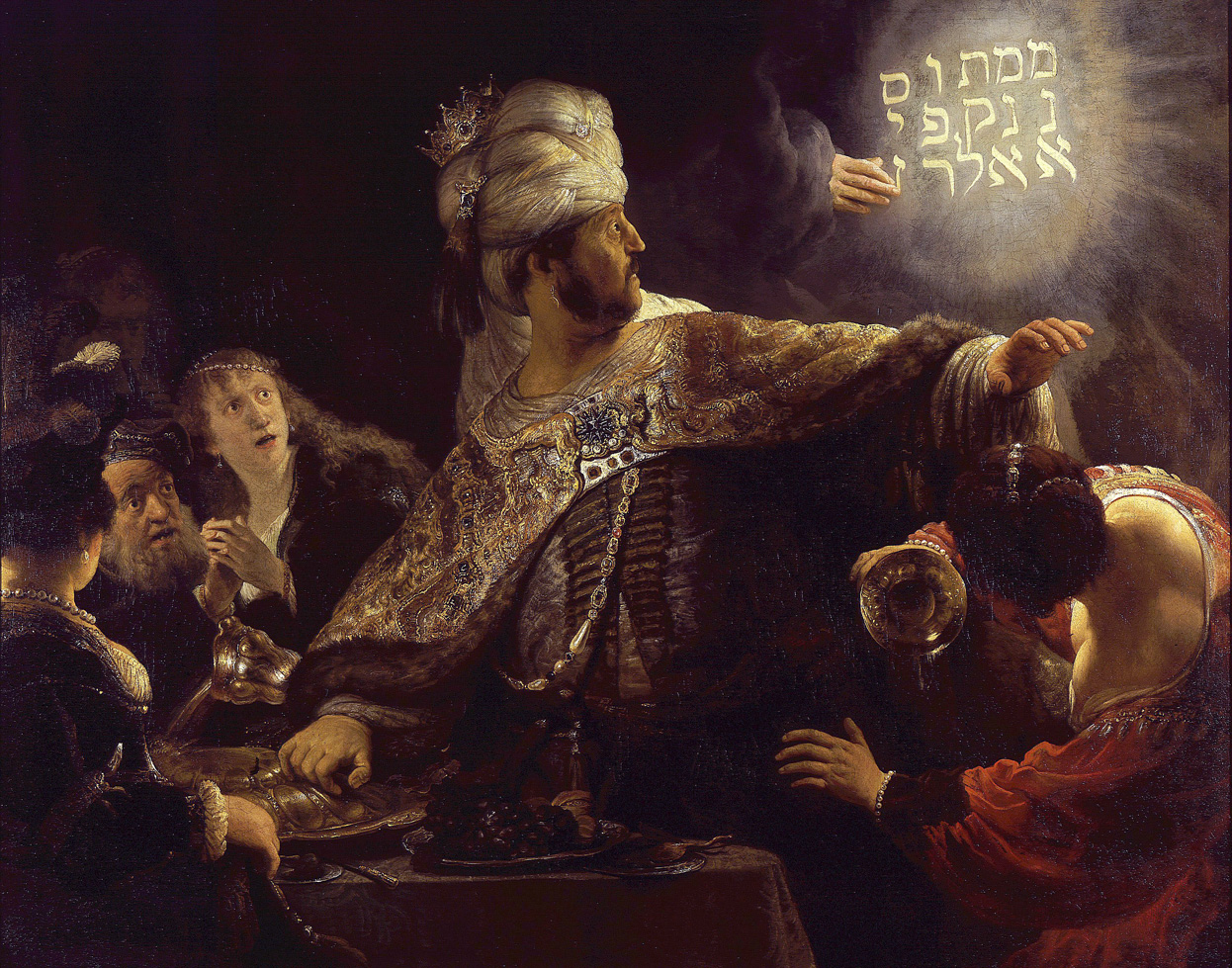
Belshazzar’s Feast, by Rembrandt van Rijn, c. 1635. National Gallery, London.
The tedium of corporate cliché has nevertheless masked how intricate the risks have in fact become. What started as an exchange for farmers and merchants of eggs and butter is now one of the largest markets for derivatives in the world. Futures contracts on such tangibles as corn and light sweet crude oil have been joined by options on the S&P 500 and credit-default swaps, the latter being insurancelike contracts that “swap” the risk of a credit default. The word “insurance” is scrupulously avoided because it would trigger all sorts of regulatory oversight. However much evasiveness is prized, the derivatives listed by the CME Group are traded on an exchange: transactions are public, and they are backed by clearinghouses that have an interest (read: skin in the game) in making sure all the parties pay up.
But the market of exchange-traded derivatives is smaller than the total value of “over-the-counter” derivatives. Or at least it is believed to be: the latter derivatives are unregulated, so nobody really knows. The term “over-the-counter,” which calls to mind the purchase of antihistamines or aspirin, is vaguely baffling and, in that sense, perfect: it essentially refers to customized securities that are privately negotiated between two parties. Side bets, as it were. In 2007, a year before the full extent of the financial wreckage became a taxpayer’s calamity, the Bank for International Settlements was estimating the value of listed credit derivatives at $548 trillion, and over-the-counter derivatives at $596 trillion. (Together, the entire derivatives market stood at $1.144 quadrillion—a unit that would be comprehensible maybe to an astrophysicist or a five-year-old playing make-believe.) The rise and fall of American International Group was due to its willingness to make these side bets and play bookie: the venerable insurance company had a financial-products division that entered into credit-default swaps in which they agreed to “insure” $441 billion worth of securities, $58 billion of which were backed by subprime loans.
When the defaults began, AIG was supposed to pay out, but because the product was called a swap, the company escaped any legal requirement to have sufficient payout money on hand. Every taxpayer knows what came next. The hand-wringing, the bailout, the outrage. The wet-noodle floggings by the various congressional hearings. The word “derivative” suddenly acquired an air of menace, though journalists still had to resort to metaphor (“sausage making,” “vampire squid”) in order to convey the full depths of the horror. Watching the parade of officials expressing shock and awe, one might be forgiven for believing that the disaster was unprecedented, when in fact it was just a larger, showier production of an act that had been performed several times already.
Enron, WorldCom, and Global Crossing were but three derivatives-fueled blowups from the past decade. In 1998, the New York Fed was able to talk Wall Street into rescuing Long-Term Capital Management, which had gorged itself on swaps (the hedge fund’s innocuous name should have aroused suspicion), because Wall Street had massive exposure to LTCM’s own massive exposure. (The 1997 financial crisis in East Asia lit the fuse; the Russian government’s default the year after sounded the explosion.) LTCM, which counted two Nobel Prize winners among its employees, was ostensibly using derivatives to exploit market inefficiencies in a way that was virtually risk-free—except when it wasn’t. Roger Lowenstein writes that a default on any one of the fund’s seven thousand derivative contracts was poised to “trigger a default in every one of the others, which covered $1.4 trillion in notional value.” A risk manager at Merrill Lynch later recalled how he and everybody else had been caught unawares: “We had no idea they would be in trouble—these people were known for risk management. They had taught it; they designed it. God knows, we were dealing with Nobel Prize winners!”
Fate leads the willing and drags along those who hang back.
And so it was that risk, and the purported ability to manage it, brought Wall Street more than once to the brink of self-annihilation. Peter Bernstein may have been right when he observed that the future no longer belongs to the gods, but we have made a habit of finding God in the strangest places, whether it be the Shroud of Turin or the formula for a derivative’s price. Finance has given the future over to mathematics and supercomputers, which, like any other prosthetic god, bring with them the temptations of both recklessness and complacency. Our technologies belong to us; we create them, and they amplify our abilities and our reach, yet we exhibit a strange eagerness to relinquish our dominion over them, endowing them with a monstrous authority that demands our accommodation and surrender. We have made a fetish out of finance, against which proper regulation gets derided as the comedy of mere mortals—not just difficult but absurd.
Nearly fifty years ago, Marshall McLuhan wrote about our tendency to become fascinated by our inventions, which are, ultimately, extensions of ourselves. As McLuhan tells it, the death of Narcissus had to do not only with his reflection but with his inability to see himself in it. Just as the words “narcosis” and “narcotics” derive from his name, Narcissus was numb; he treated his image as an object of courtship, and he willingly became its slave. McLuhan, ever alert to the perverse urge to lose our uncomfortable selves, described how Narcissus died so that we could live. We court an exquisite ruin whenever we succumb to a pretty face that we fail to recognize as our own.
